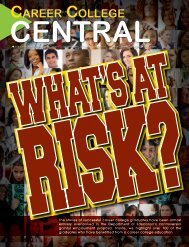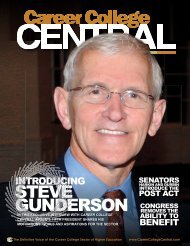Forward
Check out our latest edition online - Career College Central
Check out our latest edition online - Career College Central
- No tags were found...
You also want an ePaper? Increase the reach of your titles
YUMPU automatically turns print PDFs into web optimized ePapers that Google loves.
APSCU Best PracticesLead the Way forPostsecondaryEducation CareerServicesAPSCUis pleased to announce the releaseof "Recommendations for BestPractices in Career Services and Placement." The recommendationsaddress ways all institutions can support the transition to employmentduring the student’s entire postsecondary education experience,including campus-wide engagement in career services and effectivemanagement of a career services program.To develop these best practices, APSCU established a task forcethat convened several higher education and workforce leaders whoall provided insight to the discussion. The methods and techniqueswere cultivated from APSCU’s member institutions that currentlyoffer students rich opportunities to prepare for their future careersand personalized support for their career search process.example, some activities an institution may consider using to promotean outcomes-focused approach include:• Monitoring employment and placement rates at regular intervalsto ensure that the number of graduates in specific programs ofstudy reflects the current market demand.• Creating and implementing plans to drive continual improvementin placement outcomes.• Staying informed about workforce trends.• Identifying skills-gap issues that might be impacting placementand being proactive in designing programs to address specificworkforce needs.The role of postsecondary career education has always been tomeet employer demands for skilled workers. In turn, career-focusededucation has also strived to help its students’ goals of obtainingquality jobs. The "Recommendations for Best Practices in CareerServices and Placement" offers institutions examples of the programsthat best serve the growing new traditional student population. Newtraditional students often balance the needs of family, full-time orpart-time work, and postsecondary education.The recommendations are organized into four categories:I. Career ServicesAPSCU member institutions define their missions in helpingstudents prepare for the workforce and measure success by the levelof skill their students achieve (certificates, degrees or licensure) andgraduate employment rates, among other measures. This outcomesbasedmodel is a good fit, particularly now, when higher educationinstitutions in all sectors are being asked to demonstrate their valueto students and the public in terms of a return on investment. ForP O W E R E D B Y




